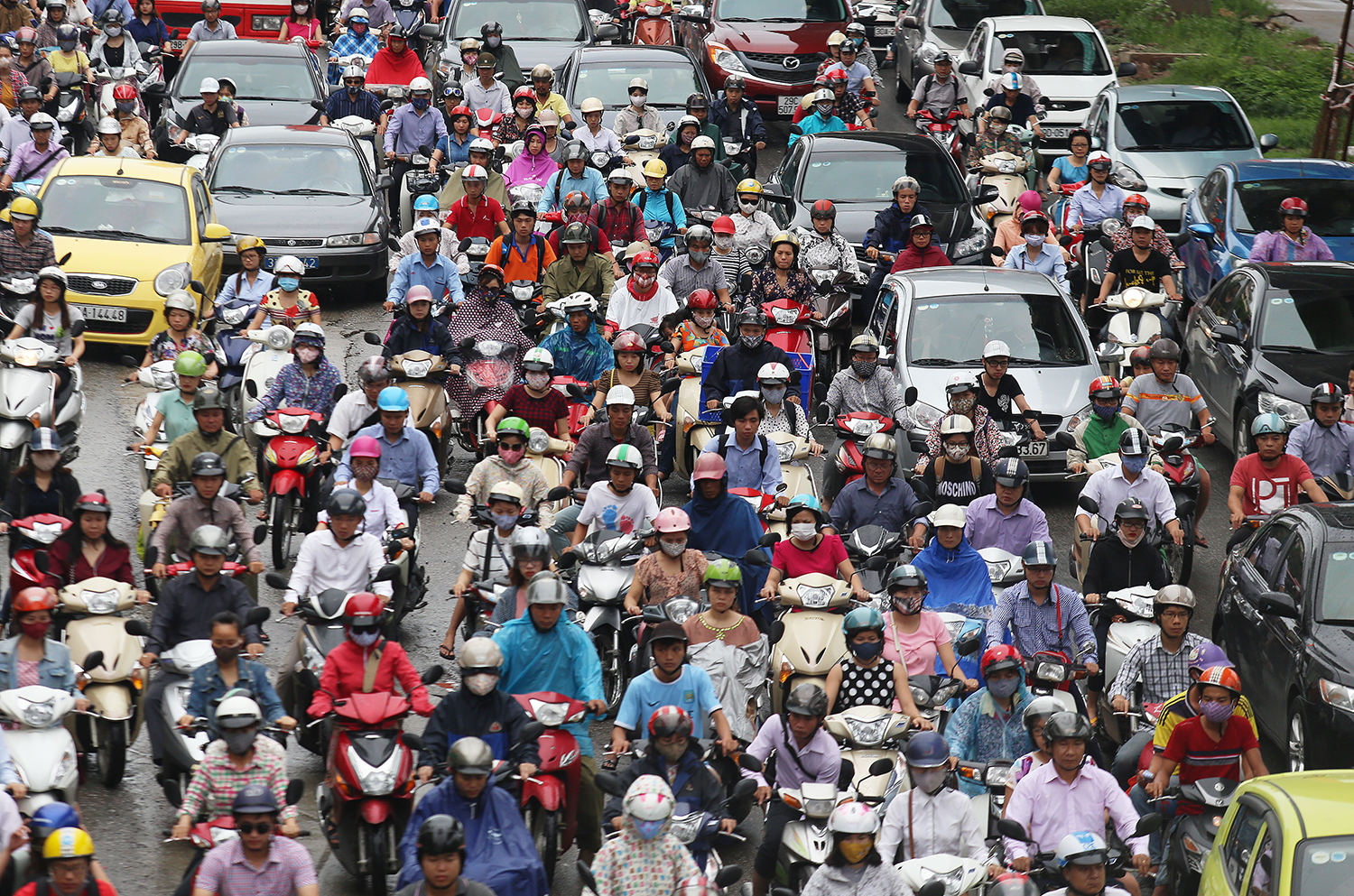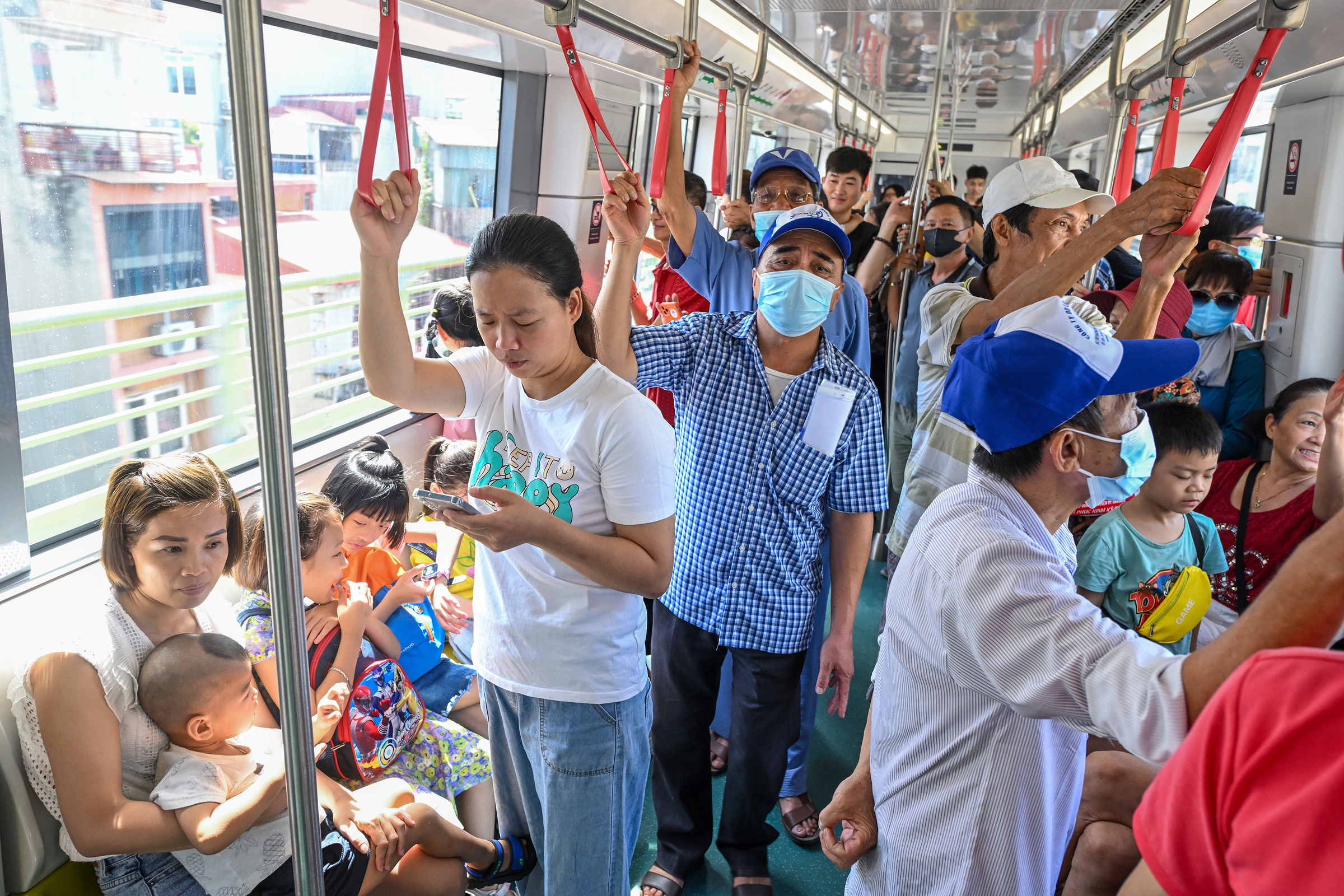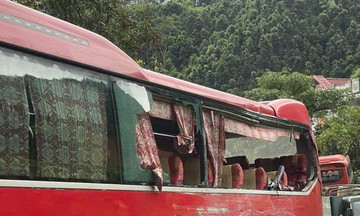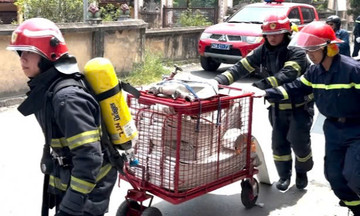Following the Prime Minister's directive, from July 2026, gasoline motorcycles will be prohibited within Hanoi's Ring Road 1, encompassing most of the four core districts: Hoan Kiem, Ba Dinh, Dong Da, and Hai Ba Trung.
From 1/1/2028, in addition to banning gasoline-powered motorcycles and mopeds, private cars using fossil fuels will also be restricted within Ring Roads 1 and 2. By 2030, this restriction will apply to all personal vehicles using fossil fuels within Ring Road 3.
 |
Ring Roads 1, 2, and 3 in Hanoi. Graphics: Hoang Khanh |
Millions of gasoline motorcycles affected
Hanoi currently has over 9.2 million vehicles, including 1.1 million cars and 6.9 million motorcycles managed by the city, with the remainder being vehicles regularly commuting from other provinces. Of the motorcycles registered in Hanoi, approximately 5.6 million are gasoline-powered, while the remaining 1.3 million are electric.
Gasoline motorcycles remain the primary mode of transport for inner-city residents, especially in the four core districts, characterized by narrow alleys stretching for kilometers and densely packed houses. With an average of two gasoline motorcycles per household and a population exceeding one million in these districts, at least 500,000 motorcycles are used daily (preliminary government statistics estimate around 450,000). This figure excludes the hundreds of thousands commuting daily from surrounding areas and neighboring provinces.
Hanoi's population is projected to increase due to rapid urbanization. By 2025, Hanoi is expected to have around 7 million motorcycles and 1.3 million cars. By 2030, these numbers are projected to reach 7.5 million motorcycles and 1.5 million cars.
Dr. Dao Ngoc Nghiem, Vice President of the Vietnam Urban Planning and Development Association, considers phasing out gasoline motorcycles a significant challenge for Hanoi due to its large population. "What will people use for transportation when public transport currently meets only one-fifth of the demand?", he questioned.
 |
Population and vehicle density in Hanoi's central districts is very high. Photo: Ngoc Thanh |
Public transport meets a small percentage of demand
Eliminating gasoline motorcycles would force residents to rely on public transport such as regular buses, bus rapid transit (BRT), metro, taxis, and ride-hailing services. While Hanoi's urban transport network has seen upgrades and new construction, it has yet to achieve its planned objectives. Delays in urban railway projects have put significant pressure on road traffic.
Hanoi planned 9 urban railway lines for the 2011-2020 period. However, only Line 2A (Cat Linh - Ha Dong) has been completed, transporting over 36.8 million passengers in nearly 4 years, averaging around 32,900 passengers per day. A section of Line 3 (Nhon - Hanoi Station), from Nhon to Kim Ma, is operational, while the remaining sections are either under construction or awaiting investment. The metro's market share is currently only 1-2%.
Buses are the primary mode of public passenger transport in Hanoi. According to transport authorities, the city currently operates 153 bus routes, covering a total length of approximately 3,850 km. In 2024, buses transported over 227.6 million passengers, and this number is projected to reach 240-250 million in 2025, equivalent to over 650,000 passengers per day. However, the bus market share remains low, at around 14% of total travel demand in 2024.
Overall, Hanoi's public transport system handles only about 19% of passenger trips, with the remainder relying on private vehicles. According to Hanoi's Master Plan, public transport is expected to meet 35-40% of demand by 2030, with private vehicles accounting for 60-65%. Thus, the majority of residents will continue to rely on private vehicles for years to come.
Dr. Phan Le Binh, Chief Representative of OCG Consulting (Japan), estimates that Hanoi's public transport will meet a maximum of 50% of daily travel demand in the coming years. "If people switch from motorcycles to buses, the bus system will be overloaded due to its limited capacity," he predicts.
 |
Passengers on the Nhon - Hanoi Station metro line. Photo: Giang Huy |
Lack of space for park-and-ride facilities
The ban on gasoline motorcycles from July 2026 will require commuters from outside Ring Road 1 to park their vehicles and transfer to other modes of transport. However, Ring Road 1 has one of the highest building densities in the city, leaving little space for parking facilities.
According to the static traffic plan, Hanoi has 1,620 designated parking areas. However, only 72 are currently operational, with 61 under preparation and facing various obstacles, as stated by Nguyen Phi Thuong, Director of the Hanoi Department of Transport, at the People's Council meeting in late 2024. Constructing parking lots is difficult because some designated areas are residential or public land, making land acquisition challenging.
Hanoi's static traffic land fund is only 0.16% of the urban construction area, while the plan requires 3-4%. Most private vehicles are parked in apartment buildings, residential areas, private homes, or informal parking spots within residential areas, on roads, sidewalks, schoolyards, agency grounds, or vacant project sites.
Limited charging station infrastructure
The elimination of gasoline vehicles will increase demand for electric motorcycles and cars. However, the current charging infrastructure is inadequate. Many residents live in narrow alleys, tube houses, or old apartment buildings without designated parking or individual electrical systems for safe charging. They often resort to unsafe and unregulated home charging methods.
Some electric vehicle manufacturers have invested in public charging stations, offering free charging for their motorcycles. However, these stations are often brand-specific and lack interoperability. Furthermore, the absence of national standards for electric motorcycle charging stations hinders consistent implementation.
Nguyen Van Thanh, former President of the Vietnam Automobile Transportation Association, suggests the city establish a public charging network at gas stations, parking lots, residential areas, and shopping centers. This network should support multiple vehicle models to prevent monopolies, promote competition, and provide convenience for residents. Additionally, safety standards for residential charging and guidelines for proper charger usage are needed to prevent fire hazards. The city and businesses should also develop solutions for collecting and disposing of used batteries.
Besides these challenges, switching from gasoline motorcycles poses a financial burden for many, especially low-income individuals. In 2024, the average per capita income in Hanoi was 163.5 million VND, while a brand-name electric motorcycle costs between 30-50 million VND.
To address this, Nguyen Van Thanh suggests Hanoi survey existing gasoline motorcycles, classifying them by age and condition to develop appropriate support packages. The city should provide assistance such as subsidized pricing and loans for electric vehicles for low-income households and workers. Support could include financial aid for vehicle replacement or travel subsidies. Furthermore, encouraging electric vehicle manufacturers to implement trade-in programs, discounts, especially for low-income groups, is crucial.
Doan Loan












